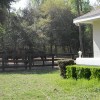Abstract
Equine facilities have unique pest management problems due to facility structure and horse husbandry practices. In Florida, homes on small equine farms are generally located in close proximity to pastures, stalls or run-in sheds, manure piles, and other fly breeding habitats. So, homeowners have a high risk of exposure to pathogens that can be transmitted by filth flies to humans. Integrated pest management for equine farms requires accurate diagnosis of pest problems and the coordinated use of science-based management practices, but a recent survey shows that many equine property owners don’t know enough about the identification, biology, and presence of filth fly pests on their properties to develop successful IPM programs. This 7-page fact sheet was written by Erika T. Machtinger, Norman C. Leppla, and Cindy Saunders, and published by the UF Department of Entomology and Nematology, March 2013.
References
American Horse Council (AHC). 2005. The Economic Impact of the Horse Industry in the United States. AHC, Washington, D.C.
Coble, H. D. and E. E. Ortman. 2009. The USA IPM Roadmap. In E.B. Radcliff, W. D. Hutchison, and R. E. Canceldo (eds.), Integrated Pest Management: Concepts, Tactics, Strategies and Case Studies. Cambridge University Press. Cambridge, England.
Florida Department of Agriculture and Consumer Services (FDACS). 2004. Florida Horse Industry. FDACS. Tallahassee, FL.
Förster, M., S. Klimpel, H. Mehlhorn, K. Sievert, S. Messler, and K. Pfeffer. 2007. Pilot study on synanthropic flies (e.g. Musca, Sarcophaga, Calliphora, Fannia, Lucilia, Stomoxys) as vectors of pathogenic microorganisms, Parasitol. Res. 101: 243-246. https://doi.org/10.1007/s00436-007-0522-y
Gerry, A. C., N. G. Peterson, and B. A. Mullens. 2007. Predicting and controlling stable flies on California dairies. University of California, Agriculture and Natural Resources. Communication Services. ANR Publication 8258. https://doi.org/10.3733/ucanr.8258
Higley L. G. and L. P. Pedigo. 1996. Economic Thresholds for Integrated Pest Management. University of Nebraska Press. Lincoln, NE.
Machtinger, E. T. 2011. Studies on the field ecology, breeding biology and parasitism of house flies, Musca domestica and stable flies, Stomoxys calcitrans, (Diptera: Muscidae) to improve integrated pest management for North Florida small equine farms. M.S. Thesis, University of Florida, Gainesville, FL.
Machtinger, E. T., C. J. Geden, J. A. Hogsette, and N. C. Leppla. 2014. Oviposition preference and development of house and stable flies in six equine facility substrates. Journal of Medical Entomology. 51:1144-1150. https://doi.org/10.1603/ME14040
Machtinger, E. T., N. C. Leppla, and J. A. Hogsette. 2016. House and stable Fly seasonal abundance, larval development substrates, and natural parasitism on small equine farms in Florida. Neotropical Entomology. 45:433-440. https://doi.org/10.1007/s13744-016-0376-z
Mullens, B. A., J. A. Meyer, and S. E. Bishop.1988. Stable fly activity on California dairies. California Agriculture 42: 20-21.
Pitzer, J. B., P. E. Kaufman, J. A. Hogsette, C. J. Geden, and S. H. Tenbroeck. 2011. Seasonal abundance of stable flies and filth fly pupal parasitoids (Hymenoptera: Pteromalidae) at Florida equine facilities. J. Econ. Entomol. 104: 1108-1115. https://doi.org/10.1603/EC10227
Reinmeyer, C. R., and B. W. Rohrbach. 1990. A survey of equine parasite control practices in Tennessee. J. Am. Vet. Med. Assoc. 196: 712-716.
(USDA) United States Department of Agriculture. 2006. Equine 2005, Part II: Changes in the U.S. Equine Industry, 1998-2005. USDA-APHIS-VS, CEAH #N452-0307. Fort Collins, CO.
Unless otherwise specified, articles published in the EDIS journal after January 1, 2024 are licensed under a Creative Commons Attribution-NonCommercial-NoDerivs 4.0 International (CC BY-NC-ND 4.0) license.

